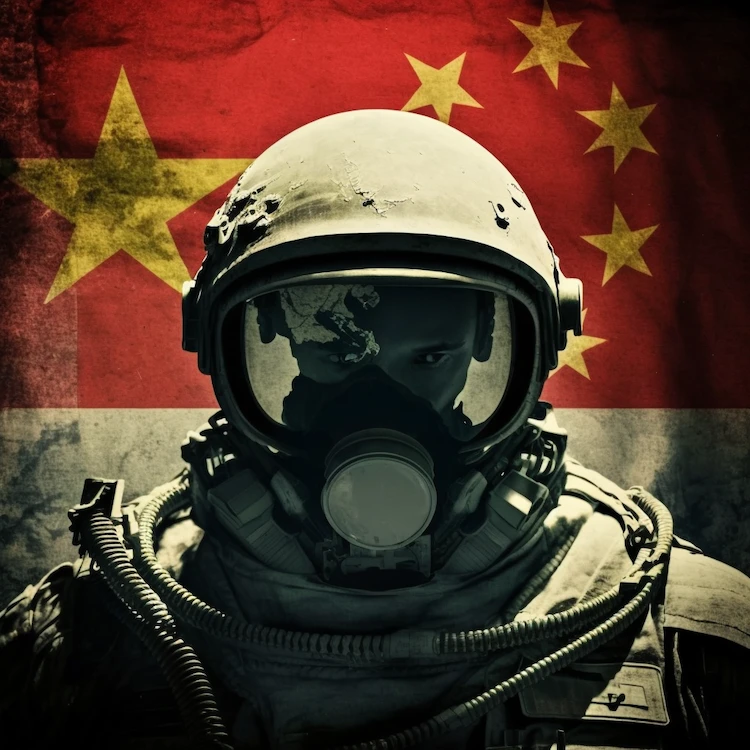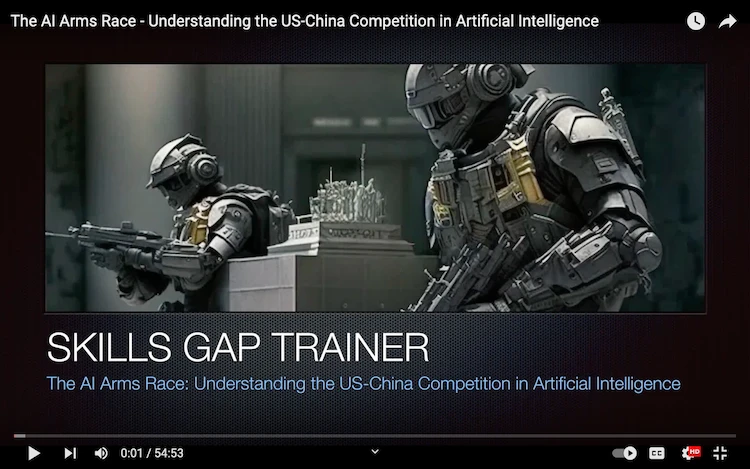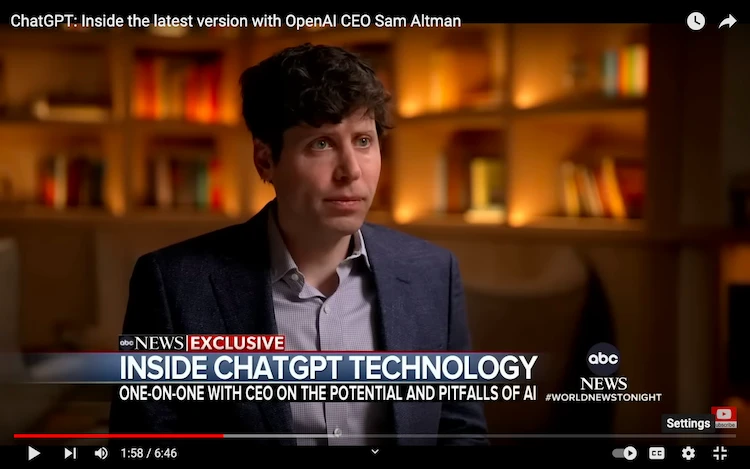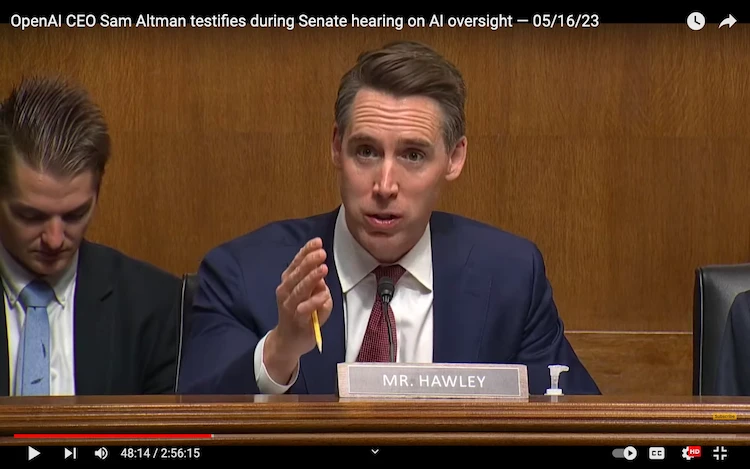I. Introduction
- A brief overview of the AI arms race between the US and China, highlighting the significance of this competition in shaping the global AI landscape and the potential consequences for the future of AI and humanity.
II. The Rise of AI and Its Global Impact
- The growing influence of AI and large language models on society
- Potential risks and challenges posed by AI, including privacy, safety, and ethical concerns
- The global implications of AI development, from economic growth to national security
III. The US-China AI Competition: Drivers and Dynamics
- The strategic objectives driving AI development in the US and China
- The role of government, industry, and academia in advancing AI research and innovation
- The factors contributing to the competitive advantage of each nation in the AI arms race
IV. Ethical Considerations in the US-China AI Competition
- The importance of ethical guidelines and principles in AI development
- The potential for AI to be weaponized or used for surveillance and social control
- How the AI arms race could impact global norms and standards for AI ethics and safety
V. International Cooperation and Conflict Prevention
- The need for global coordination and cooperation to address the AI Dilemma
- Potential areas for collaboration between the US and China in AI research and development
- Strategies for promoting responsible AI development and mitigating the risk of an AI arms race escalating into conflict
VI. Lessons from the AI Dilemma and Future Prospects
- The importance of diverse perspectives and a comprehensive approach to AI safety and regulation in the context of the US-China AI competition
- The potential for AI to contribute to medical discoveries, environmental solutions, and societal advancements
- How the AI arms race can inform our understanding of the AI Dilemma and guide us towards a more responsible and balanced future for AI
VII. Conclusion
- A synthesis of the key insights and lessons learned from examining the US-China AI arms race, emphasizing the global implications of this competition and the need for collaboration, ethical considerations, and responsible AI development to ensure a safe and beneficial future for artificial intelligence and humanity as a whole.

I. Introduction
The rapid advancements in artificial intelligence (AI) have given rise to an intense competition between global powers, particularly the United States and China. As the frontrunners in AI research and development, these two nations are locked in a race to dominate the AI landscape and harness its transformative potential for their respective economic, technological, and military interests. This AI arms race not only has profound implications for the geopolitical balance of power but also raises critical questions about the future of AI and its impact on humanity.
The significance of the US-China AI competition extends far beyond their borders, influencing the global AI ecosystem, shaping international norms and standards, and affecting the trajectory of AI innovation. As both countries invest heavily in AI research, there is a growing urgency to address the potential risks and ethical concerns associated with AI technologies, such as privacy, surveillance, and autonomous weapons.
In this article, we delve into the intricacies of the US-China AI arms race, exploring the drivers and dynamics of this competition, its ethical considerations, and the global implications for AI development and regulation. By examining the US-China AI rivalry, we hope to contribute to a deeper understanding of the AI Dilemma and emphasize the importance of responsible AI development and international cooperation in navigating the exciting yet perilous journey into the future of AI and humanity.
The US-China AI arms race is a complex and multifaceted phenomenon, driven by a confluence of strategic, economic, and technological factors. As both nations vie for AI supremacy, the stakes are high, with the outcome of this competition shaping the global landscape of innovation, ethics, and policy. In this article, we present a comprehensive analysis of the US-China AI arms race, highlighting the key drivers, dynamics, and ethical considerations that underpin this contest, and exploring the potential consequences of this rivalry for the future of AI and humanity. Through this examination, we aim to foster a greater understanding of the AI Dilemma and illuminate the path toward a more responsible, balanced, and beneficial future for artificial intelligence.
II. The Rise of AI and Its Global Impact

A. The growing influence of AI and large language models on society
Artificial intelligence (AI) and large language models have grown increasingly influential in modern society, revolutionizing various sectors and changing the way we live, work, and interact. As AI technologies become more sophisticated, their impact extends beyond the realms of science and technology, permeating various aspects of our daily lives and transforming industries such as healthcare, finance, and transportation.
Large language models, such as GPT-3, have demonstrated remarkable capabilities in natural language understanding, generation, and translation, opening up new avenues for human-machine interaction and information dissemination. These models are increasingly used in applications ranging from virtual assistants and customer service chatbots to content creation and sentiment analysis. As AI-powered language models become more prevalent, they are shaping the way we communicate, access information, and make decisions.
The growing influence of AI and large language models on society is a double-edged sword. On the one hand, these technologies hold immense potential to improve efficiency, reduce costs, and enhance our quality of life. On the other hand, they raise critical concerns related to privacy, security, and ethics, such as the potential for mass surveillance, disinformation, and algorithmic bias.
In the context of the US-China AI arms race, the influence of AI and large language models on society underscores the importance of this competition in determining the future direction of AI development and its broader societal implications. As both nations vie for AI supremacy, their strategies and policies will not only shape the AI landscape but also influence how these powerful technologies are harnessed, regulated, and integrated into our lives. By understanding the growing influence of AI and large language models on society, we can better appreciate the stakes of the US-China competition and the need for responsible AI development and international cooperation to address the AI Dilemma.

B. Potential risks and challenges posed by AI, including privacy, safety, and ethical concerns
As AI technologies continue to advance and become more integrated into various aspects of society, they bring with them a host of potential risks and challenges that must be carefully considered and addressed. Among these concerns are privacy, safety, and ethical issues, which can have significant consequences for individuals and communities worldwide.
Privacy concerns arise from the vast amounts of data required to train and operate AI systems. AI algorithms often rely on personal and sensitive information, which, if not properly protected, can be exploited by malicious actors or inadvertently disclosed. Moreover, the widespread use of AI in surveillance and monitoring applications has raised questions about the erosion of individual privacy and the potential for mass surveillance.
Safety concerns emerge as AI systems increase in complexity and autonomy. As AI systems become more sophisticated, they can also become more difficult to control, predict, and understand. This unpredictability raises questions about the potential for accidents, unintended consequences, and malicious use of AI technologies, such as the development of autonomous weapons or the use of AI to create deepfake content for disinformation campaigns.
Ethical concerns are prevalent in the development and deployment of AI systems. Algorithmic bias, fairness, transparency, and accountability are among the key ethical considerations that must be addressed to ensure AI technologies do not exacerbate existing inequalities or create new ones. Additionally, the potential displacement of human labour due to automation and the ethical implications of AI-driven decision-making in critical areas like healthcare, criminal justice, and finance are also sources of concern.
In the context of the US-China AI arms race, these risks and challenges underscore the importance of responsible AI development and international cooperation. As both nations compete to dominate the AI landscape, it is crucial that they prioritize the development of AI technologies that address these concerns and promote a global AI ecosystem that upholds human rights, privacy, safety, and ethical standards. By recognizing and addressing the potential risks and challenges posed by AI, we can work towards a future where AI technologies are harnessed responsibly and for the betterment of all.

C. The global implications of AI development, from economic growth to national security
The rapid development and integration of AI technologies have far-reaching global implications that impact various aspects of society. Among these are economic growth, national security, and international relations. The competition between the US and China in AI development has intensified these implications, emphasizing the need for a comprehensive understanding of the potential consequences of AI advancements.
In terms of economic growth, AI has the potential to drive significant gains by increasing productivity, streamlining processes, and enabling new business models. As the US and China vie for global AI leadership, their investments in AI research and development can create ripple effects throughout the global economy. However, the unequal distribution of AI benefits may exacerbate existing inequalities both within and between countries, as some regions may gain more from AI-driven growth than others.
Concerning national security, AI technologies are increasingly utilized for military and defence purposes, including autonomous weapons systems, advanced surveillance, and intelligence analysis. This raises concerns about AI’s potential to disrupt the balance of power, increase the risk of conflict, and contribute to a new arms race between nations. The competition between the US and China in AI development heightens these concerns, as both nations seek to leverage AI capabilities for strategic advantage.
Regarding international relations, the race for AI dominance between the US and China carries broader implications as countries either align themselves with one of the two nations or pursue their own AI development strategies. The competition can exacerbate existing tensions and create new divides as countries vie for access to AI technologies, skilled talent, and investment opportunities. Cooperation and coordination between nations are essential to ensuring a global AI ecosystem that promotes peace, stability, and shared prosperity.

In conclusion, the global implications of AI development, driven by the US-China competition, touch on various aspects of society, from economic growth to national security and international relations. It is crucial for policymakers, researchers, and industry leaders to recognize these implications and collaborate to address potential risks and challenges while maximizing the benefits of AI advancements for all. By fostering collaboration and ensuring responsible AI development, we can create a future in which AI serves the greater good of humanity and contributes to a more equitable and prosperous world.
III. The US-China AI Competition: Drivers and Dynamics

A. The strategic objectives driving AI development in the US and China
The competition between the US and China in AI development is fuelled by a range of strategic objectives, reflecting the importance both nations place on AI as a critical component of their future economic, military, and geopolitical power. Understanding these strategic objectives helps to shed light on the drivers and dynamics of the US-China AI competition.
Economic dominance is a key factor for both the US and China, as they recognize the potential of AI to drive economic growth and productivity. As a result, they are investing heavily in AI research and development, aiming to establish themselves as global AI leaders and secure the economic benefits that come with technological supremacy. These benefits include increased productivity, job creation, and the establishment of new industries.
Military advantage is another driving force, with AI transforming the landscape of modern warfare and defence. The US and China both see AI as a strategic asset that can provide a significant advantage in military operations, from autonomous weapons systems to advanced surveillance and intelligence analysis. The competition in AI development is thus partly driven by the desire to maintain or gain a military edge over potential adversaries.
Geopolitical influence plays a role as AI reshapes the global balance of power, and the US and China are vying for influence in this emerging domain. Dominance in AI can translate into geopolitical influence through the establishment of international standards, influence over global AI governance, and the ability to shape the rules of the digital economy. Both nations aim to leverage their AI capabilities to strengthen their positions on the world stage and advance their respective political agendas.
Technological innovation is another strategic objective, with the US and China both seeking to become global centers of technological innovation, with AI being a key area of focus. By fostering a robust AI research ecosystem, attracting top talent, and promoting the commercialization of AI technologies, both countries aim to maintain their positions at the forefront of technological advancements and shape the future direction of AI.
National security and domestic stability are also important considerations, as AI can play a crucial role in enhancing national security and domestic stability. Both the US and China are leveraging AI technologies to improve their capabilities in areas such as cyber defense, public safety, and crisis response. Additionally, AI can be used to strengthen domestic surveillance and social control, particularly in the case of China, where the government has employed AI-driven tools to monitor and manage its population.
In conclusion, the strategic objectives driving AI development in the US and China are multifaceted, encompassing economic, military, geopolitical, technological, and domestic considerations. As the US-China AI competition intensifies, it is critical for policymakers, researchers, and industry leaders to understand these drivers and dynamics in order to develop effective strategies for navigating the challenges and opportunities presented by the AI arms race.

B. The role of government, industry, and academia in advancing AI research and innovation
The advancement of AI research and innovation in both the US and China is fueled by the collaborative efforts of government, industry, and academia. Each of these sectors plays a unique and essential role in driving the development and deployment of AI technologies and shaping the competitive landscape of AI.
Government plays a pivotal role in AI development by setting strategic priorities, providing funding and resources, and establishing a regulatory framework for AI research and deployment. In the US, government agencies such as the National Science Foundation and the Department of Defense contribute to AI research through grants, contracts, and direct investment. In China, the government has outlined ambitious national plans for AI development and has committed significant resources to support AI research and industrialization.
Furthermore, governments shape the regulatory environment for AI, influencing issues such as data privacy, intellectual property, and AI ethics. By setting policies and standards, governments can create incentives for responsible AI development and ensure that the benefits and risks of AI are appropriately managed.
Industry plays a crucial role in AI development by translating research advances into commercially viable products and services. Companies in the US and China, including tech giants like Google, Facebook, Alibaba, and Tencent, invest heavily in AI research and development, driving innovation in areas such as natural language processing, computer vision, and autonomous systems. Industry also fosters collaboration between researchers and practitioners, enabling the rapid transfer of knowledge and skills between academia and the commercial sector.
Additionally, industry contributes to the development of AI talent through the establishment of research centers, the provision of internships and job opportunities, and the support of educational programs and initiatives.
Academic institutions are the backbone of AI research, generating new knowledge and breakthroughs that drive AI innovation. Universities and research institutions in the US and China, such as Stanford, MIT, Tsinghua University, and the Chinese Academy of Sciences, produce cutting-edge research in AI theory and applications. Academia also plays a critical role in training the next generation of AI researchers, engineers, and entrepreneurs.
Collaboration between academia and industry is essential for fostering a dynamic AI ecosystem. In both the US and China, universities and research institutions frequently partner with companies to conduct joint research projects, share resources and expertise, and develop new technologies and applications.
In conclusion, the advancement of AI research and innovation in the US and China is driven by the interplay between government, industry, and academia. Understanding the roles and contributions of these sectors, as well as the ways in which they collaborate and interact, is crucial for developing a comprehensive understanding of the US-China AI competition and its global implications.

C. The factors contributing to the competitive advantage of each nation in the AI arms race
Both the United States and China possess unique strengths and capabilities that contribute to their competitive advantage in the AI arms race. These factors include the quality and quantity of data, talent pool, innovation ecosystems, government support, and global influence.
Data is a crucial resource for AI development, particularly for machine learning algorithms that rely on vast amounts of data to learn and improve. China has a competitive advantage in this area due to its large population and the extensive digital footprint of its citizens. The abundance of data in China enables its AI systems to be trained on more diverse and representative datasets, improving their performance and generalizability.
The US, on the other hand, has a competitive advantage in data quality and the development of advanced data processing techniques. US companies and research institutions have access to high-quality datasets from various sectors, such as healthcare, finance, and defense, which can drive more sophisticated AI applications.
Talent is another key factor in the AI arms race. The US has long been a global leader in AI talent, with world-class universities, research institutions, and tech companies that attract and retain top researchers and engineers from around the world. The US also has a strong culture of entrepreneurship and innovation, which nurtures the development of AI startups and encourages risk-taking.
China, however, has made significant strides in recent years to close the talent gap. The Chinese government has invested heavily in AI education and research, with a focus on building a strong domestic talent pool. Chinese universities are also increasingly competitive in AI research, and the country is becoming an attractive destination for international talent.
Innovation ecosystems play a crucial role in driving AI research and development. In the US, the combination of strong academic institutions, well-funded research labs, and a thriving startup culture creates an environment that encourages cutting-edge AI research and commercialization.
China’s innovation ecosystem is also rapidly evolving, with government-backed AI research parks, incubators, and accelerators, as well as strong support from the private sector. The Chinese government’s strategic focus on AI has helped to create a fertile ground for AI innovation and commercialization.
Government support is another key factor in the AI arms race. Both the US and China have recognized the strategic importance of AI and have implemented ambitious national plans to support AI innovation. However, the Chinese government’s centralized approach and commitment to long-term investments give it an advantage in terms of scale and speed of implementation.
Global influence further shapes the competitive advantage of each nation in the AI arms race. The US has a long-standing global influence in technology, which extends to AI. Many of the world’s leading AI companies and research institutions are based in the US, and American AI technology and standards have been widely adopted internationally. This influence gives the US a competitive advantage in shaping the global AI landscape.
China, on the other hand, is rapidly expanding its global influence through initiatives such as the Belt and Road Initiative and overseas investments in AI research and development. As China’s influence grows, so does its ability to shape the global AI landscape in ways that align with its strategic interests.
In conclusion, the competitive advantage of each nation in the AI arms race is shaped by a variety of factors, including data, talent, innovation ecosystems, government support, and global influence. Understanding these factors and their interplay is crucial for assessing the dynamics of the US-China AI competition and its global implications.
IV. Ethical Considerations in the US-China AI Competition

A. The importance of ethical guidelines and principles in AI development
The development of artificial intelligence (AI) systems has far-reaching implications for society, with the potential to revolutionize industries, streamline processes, and improve the quality of life for many. However, the rapid advancement of AI technologies also raises a myriad of ethical concerns, making it imperative for the US and China to prioritize ethical guidelines and principles in their AI development strategies.
Ensuring fairness and equality in AI systems is of paramount importance. AI technologies have the potential to perpetuate existing biases and inequalities if not developed and deployed responsibly. By adhering to ethical guidelines and principles, developers can design AI systems that treat all individuals fairly, regardless of their race, gender, or socioeconomic status. This approach helps avoid unfair discrimination and promotes social equity.
Privacy and data protection are also critical ethical considerations in AI development. As AI systems increasingly rely on massive amounts of personal data to function, concerns about privacy and data protection grow. Implementing ethical guidelines and principles can help establish robust data protection standards that safeguard individual privacy while enabling AI innovation.
The complexity of AI algorithms can lead to a lack of transparency and accountability in their decision-making processes. Ethical guidelines and principles can promote the development of explainable AI systems, enabling users to understand how decisions are made and holding developers accountable for the potential consequences of their AI systems.

Addressing safety and security concerns in AI development is essential. AI systems, if left unchecked, can pose significant safety and security risks, including unintended consequences and vulnerabilities to cyberattacks. Ethical guidelines and principles can help ensure that AI developers prioritize safety and security considerations during the development process, minimizing potential risks and harm.
Lastly, human-centric AI development should be at the forefront of the AI arms race. It is crucial that AI technologies are developed with a focus on enhancing human well-being and preserving human values. Ethical guidelines and principles can help ensure that AI development is human-centric, prioritizing human needs and aspirations while mitigating potential negative consequences.
In conclusion, the importance of ethical guidelines and principles in AI development cannot be overstated. As the US and China compete in the AI arms race, incorporating ethical considerations into their AI development strategies will be essential for minimizing potential risks, ensuring equitable outcomes, and fostering trust in AI technologies. By prioritizing ethical AI development, both nations can contribute to a future where AI serves as a force for good, benefiting humanity as a whole.

B. The potential for AI to be weaponized or used for surveillance and social control
As AI technologies continue to advance, concerns arise regarding the potential for their weaponization or use in surveillance and social control. It is critical for the US and China to address these ethical concerns as they compete in the AI arms race to ensure the responsible development and deployment of AI technologies.
The development of autonomous weapons systems raises ethical questions regarding the potential loss of human control in life-and-death decisions. These systems may not possess the necessary moral and ethical judgment to make appropriate decisions in combat situations, leading to unintended civilian casualties and the escalation of conflicts.

In the realm of surveillance, AI-powered technologies such as facial recognition and predictive policing have the potential to infringe on individual privacy and civil liberties. In some instances, these technologies have been deployed to monitor and suppress dissent, leading to human rights abuses and an erosion of democratic values.
AI-enabled social credit systems can be used to monitor, evaluate, and shape citizens’ behaviour based on a set of predefined criteria. These systems raise concerns about privacy, fairness, and the potential for discrimination, as well as the risk of creating a surveillance state that stifles individual freedom and autonomy.
The manipulation of information is another area of concern, as AI technologies such as deepfakes and algorithmic content recommendation can be employed to spread disinformation and manipulate public opinion. This can undermine trust in democratic institutions, exacerbate social divisions, and destabilize societies.
Lastly, cybersecurity threats pose a significant risk. AI systems can be weaponized to launch sophisticated cyberattacks, causing significant damage to critical infrastructure, financial systems, and sensitive data. Ensuring AI security and robustness is crucial to mitigating these threats and maintaining international stability.
To address these concerns, it is essential for the US and China to develop and adhere to ethical guidelines and principles that prioritize responsible AI development and deployment. This includes fostering international collaboration, establishing transparency and accountability mechanisms, and actively engaging with diverse stakeholders to ensure a comprehensive approach to AI ethics. By working together to address the ethical challenges posed by AI, both nations can contribute to a future where AI technologies are used responsibly and for the betterment of humanity.

C. How the AI arms race could impact global norms and standards for AI ethics and safety
As the US and China continue to compete in the development of AI technologies, their influence on global norms and standards for AI ethics and safety becomes increasingly significant. The AI arms race presents both opportunities and challenges in shaping these standards.
One opportunity lies in fostering international collaboration and consensus-building around AI ethics and safety. Both countries recognize the importance of responsible development, and by working together and engaging with other countries, the US and China can help establish global guidelines that promote the safe and ethical use of AI technologies.
As global leaders in AI, the US and China have the power to set the standards for AI ethics and safety. Their commitment to ethical development will influence other countries and shape the trajectory of AI research, development, and deployment worldwide.
However, differences in cultural values, political systems, and economic priorities between the US and China may lead to divergent approaches to AI ethics and safety. These differences could make it difficult to reach a consensus on global standards, increasing the potential for AI misuse and unethical practices.
The competitive nature of the AI arms race may also incentivize the US and China to prioritize rapid AI development over ethical considerations, leading to a race to the bottom in AI safety and ethics. This could result in the widespread deployment of AI systems with inadequate safety measures or insufficient ethical oversight, posing risks to individuals and societies.
Striking the right balance between encouraging AI innovation and ensuring ethical development is critical. Overregulation may stifle progress, while insufficient regulation could lead to AI systems being deployed without proper safeguards in place.
To navigate these challenges, the US and China must work together to create an environment that promotes responsible AI development and the establishment of global norms and standards for AI ethics and safety. This includes fostering dialogue, cooperation, and the sharing of best practices among all stakeholders, as well as engaging with international organizations and other countries to develop a comprehensive and inclusive approach to AI ethics and safety. By doing so, they can ensure that the AI arms race leads to positive outcomes for humanity and a future where AI technologies are used responsibly and for the betterment of all.

V. International Cooperation and Conflict Prevention

A. The need for global coordination and cooperation to address the AI Dilemma
The rapid advancements in AI technology and the intensifying AI arms race between the US and China underscore the urgent need for global coordination and cooperation to address the AI Dilemma. By fostering international collaboration, we can mitigate potential risks and maximize the benefits of AI for all.
Both the US and China, as well as other nations, face shared challenges in navigating the AI Dilemma. By acknowledging common goals such as ensuring AI safety, promoting ethical development, and harnessing AI for global good, countries can find common ground for cooperation.
International cooperation can enable the sharing of best practices, research findings, and knowledge in AI development. Collaborative efforts can accelerate the discovery of AI safety mechanisms, ethical guidelines, and responsible deployment strategies, benefiting all parties involved.
The development of universally accepted standards for AI ethics, safety, and regulation is crucial for responsible AI growth. Through collaboration, countries can work together to create a global framework that promotes transparency, accountability, and fairness in AI applications.

By engaging in open dialogue and fostering trust among nations, the potential for misunderstandings and conflicts arising from the AI arms race can be reduced. Cooperation can facilitate the establishment of norms and agreements that prevent the weaponization of AI and ensure its use for peaceful purposes.
Multilateral forums, such as the United Nations, can serve as platforms for dialogue and cooperation on AI-related issues. These forums can facilitate the development of international agreements and frameworks, helping to create a shared understanding of the challenges and opportunities posed by AI.
To address the AI Dilemma effectively, international cooperation and coordination are vital. By working together and pooling resources, nations can overcome the challenges presented by the AI arms race and ensure that AI technologies are developed and deployed responsibly, safely, and for the benefit of humanity as a whole.

B. Potential areas for collaboration between the US and China in AI research and development
Despite the competitive nature of the AI arms race, there are several potential areas for collaboration between the US and China in AI research and development. By working together, both nations can accelerate the development of beneficial AI technologies and address shared challenges.
One potential area of collaboration is the application of AI for social good. Both the US and China can work together on projects that address global challenges such as climate change, poverty alleviation, and public health. Joint research initiatives can foster the development of AI-driven solutions that have a positive impact on society and the environment.
Ensuring the safety and ethical use of AI is a shared concern for both countries, and collaboration in this area can help establish common ethical principles, safety guidelines, and best practices for the responsible development and deployment of AI technologies.
Encouraging open-source AI development and sharing AI-related resources can lead to a greater exchange of ideas and knowledge between the US and China, fostering innovation and reducing the potential for AI technologies to be weaponized or misused.
Establishing joint research centers and initiatives can promote collaboration between leading AI researchers from the US and China. These partnerships can help bridge the gap between academia, industry, and government, facilitating the exchange of expertise and fostering innovation.
Developing global standards for AI ethics, safety, and regulation requires international cooperation. The US and China can work together to create a shared framework that promotes transparency, fairness, and accountability in AI applications.
Facilitating the exchange of AI talent between the US and China can help nurture a global community of AI researchers and experts. This can lead to the development of new ideas, technologies, and solutions that benefit both countries and the world at large.
By collaborating in these potential areas, the US and China can mitigate the risks associated with the AI arms race while maximizing the benefits of AI technology for the global community. Cooperation in AI research and development can help both nations address shared challenges, ensuring that AI technologies are developed and deployed responsibly and for the greater good of humanity.

C. Strategies for promoting responsible AI development and mitigating the risk of an AI arms race escalating into conflict
In order to promote responsible AI development and mitigate the risk of an AI arms race escalating into conflict, a comprehensive strategy that incorporates multiple approaches must be adopted. These strategies should aim to foster international cooperation, establish shared ethical and safety standards, and encourage transparency and accountability in AI research and development.
Developing and promoting shared ethical principles and safety guidelines for AI can help ensure that the technology is used responsibly and for the benefit of all. This includes addressing issues such as privacy, data security, and potential biases in AI algorithms. Creating international regulatory frameworks for AI technologies can help set common standards and promote responsible AI development. These frameworks should be designed to protect user privacy, ensure data security, and prevent the weaponization of AI.
Building alliances and partnerships among countries, including the US and China, can help foster collaboration on AI research and development. This can lead to the establishment of joint research initiatives, shared resources, and the exchange of expertise, which can contribute to responsible AI development. Encouraging transparency in AI research and development can help build trust among countries and prevent the misuse of AI technologies. This includes the sharing of research findings, the open publication of AI algorithms, and the development of AI auditing mechanisms to ensure compliance with ethical and safety standards.
Investing in AI research and development that addresses global challenges such as climate change, poverty alleviation, and public health can help focus AI development on beneficial applications. By working together on these shared goals, countries can foster a sense of common purpose and reduce the risk of conflict arising from the AI arms race.
Establishing mechanisms for resolving AI-related disputes and conflicts can help prevent the escalation of tensions in the AI arms race. This may include the creation of international AI oversight bodies, the development of AI emergency response teams, and the adoption of treaties and agreements that govern the use of AI in military and security applications.
By adopting these strategies, countries can work together to promote responsible AI development and mitigate the risks associated with the AI arms race. This collaborative approach can help ensure that AI technologies are developed and deployed for the benefit of humanity while minimizing the potential for conflict and harm.
VI. Lessons from the AI Dilemma and Future Prospects

A. The importance of diverse perspectives and a comprehensive approach to AI safety and regulation in the context of the US-China AI competition
As the US and China continue to advance their respective AI capabilities, it is crucial to adopt diverse perspectives and a comprehensive approach to AI safety and regulation. The AI Dilemma has shown that rapid technological advancements can lead to unintended consequences and exacerbate existing inequalities if not managed responsibly. By incorporating diverse perspectives and addressing the various dimensions of AI development, stakeholders can work together to create a more equitable and secure AI ecosystem.
Ensuring that AI development and regulation processes include input from individuals with diverse backgrounds, experiences, and expertise helps address potential biases and blind spots in AI systems. This can lead to the creation of AI technologies that are more beneficial and accessible to all, while reducing the risk of perpetuating existing inequalities.
Adopting a multidisciplinary approach to AI safety and regulation can help address the complex, interconnected challenges posed by AI advancements. By incorporating insights from fields such as computer science, ethics, law, sociology, and psychology, stakeholders can develop more effective and comprehensive strategies to manage the potential risks associated with AI.
Fostering open communication and collaboration between the US and China, as well as other nations and international organizations, is essential for promoting responsible AI development. By engaging in dialogue and working together to establish common standards and best practices, countries can mitigate the risks associated with the AI arms race and ensure that AI technologies are developed for the benefit of all.
As AI technologies continue to evolve, it is vital for stakeholders to remain adaptable and responsive to emerging challenges and opportunities. By embracing a culture of continuous learning and adaptation, policymakers and industry leaders can stay ahead of the curve and develop effective strategies for addressing new AI-related risks and ethical dilemmas.
Raising awareness and fostering public understanding of AI technologies and their implications is essential for ensuring informed decision-making and responsible AI development. By promoting public engagement and education, stakeholders can encourage more inclusive and democratic discussions about AI safety and regulation, helping to shape policies that reflect the diverse needs and perspectives of society.
By embracing diverse perspectives and a comprehensive approach to AI safety and regulation, stakeholders can better navigate the challenges posed by the US-China AI competition and ensure that AI advancements are harnessed for the greater good of humanity.

B. The potential for AI to contribute to medical discoveries, environmental solutions, and societal advancements
As the US and China continue to invest in AI research and development, it is crucial to recognize the tremendous potential AI has to drive breakthroughs in various fields, including medicine, environmental sustainability, and societal advancements. Harnessing AI’s capabilities for the greater good can help mitigate the risks associated with the AI arms race and ensure that the technology is used to benefit all of humanity.
AI has the potential to revolutionize healthcare by accelerating the discovery of new treatments and therapies, improving diagnostics, and personalizing patient care. Machine learning algorithms can analyze large datasets to identify patterns and relationships, leading to novel insights that can improve disease prevention, diagnosis, and treatment. Collaboration between the US and China in medical AI research could lead to breakthroughs that benefit people worldwide.
AI can play a significant role in addressing pressing environmental challenges such as climate change, pollution, and biodiversity loss. By analyzing complex data, AI systems can optimize energy consumption, identify pollution sources, and develop strategies for sustainable resource management. Cooperation in AI-driven environmental solutions can foster global collaboration and help the US and China contribute to achieving the United Nations’ Sustainable Development Goals.
AI has the potential to transform various sectors, from education to transportation, resulting in improved quality of life and increased social well-being. AI-driven innovations can enable personalized learning experiences, enhance public safety, and create more efficient transportation systems. Encouraging joint research and development efforts between the US and China in these areas can promote global progress and ensure that the benefits of AI are widely shared.
Harnessing the potential of AI in these fields requires careful consideration of ethical implications, including issues related to privacy, fairness, and transparency. By learning from the AI Dilemma and incorporating diverse perspectives, stakeholders can develop responsible AI systems that respect human rights and values while maximizing the technology’s potential to drive medical discoveries, environmental solutions, and societal advancements.
As the US and China continue to compete in AI development, it is crucial to recognize and seize the opportunities for collaboration in areas that have the potential to benefit all of humanity. By working together to harness AI’s capabilities for medical discoveries, environmental solutions, and societal advancements, the two nations can help ensure a safer and more equitable future for all.
C. How the AI arms race can inform our understanding of the AI Dilemma and guide us towards a more responsible and balanced future for AI
The AI arms race between the US and China provides valuable insights into the AI Dilemma, which refers to the challenges of balancing innovation and safety in the development and deployment of artificial intelligence technologies. By examining the dynamics of the AI arms race, we can better understand the potential risks and opportunities associated with AI and adopt strategies to promote responsible development and usage.
Learning from past mistakes, the AI arms race offers an opportunity to study the consequences of rapid technological advancement, as well as the potential pitfalls of prioritizing competition over collaboration. By learning from past experiences, such as the social media precedent, we can develop policies and strategies that prevent the negative consequences of AI and ensure its responsible use.
The AI arms race highlights the need for international cooperation in addressing the AI Dilemma. By working together on shared challenges, such as AI ethics and safety, countries can foster global norms and standards that promote responsible AI development and mitigate the risk of conflict.
The AI arms race can serve as a catalyst for greater trust and transparency in AI development. Encouraging open dialogue between stakeholders, including governments, industry, and academia, can help build consensus around best practices and shared objectives, leading to more responsible and accountable AI systems.
The AI arms race provides a platform for countries to demonstrate leadership in responsible AI development. By prioritizing ethical guidelines, investing in safety research, and collaborating on global initiatives, the US and China can contribute to a more balanced and sustainable future for AI.
Emphasizing the importance of diverse perspectives, the AI arms race underscores the need for diverse perspectives in addressing the AI Dilemma. By incorporating insights from various stakeholders, including ethicists, policymakers, and marginalized communities, we can develop AI systems that are fair, inclusive, and truly beneficial to all.

In conclusion, the AI arms race between the US and China can serve as a valuable source of lessons for understanding the AI Dilemma and guiding us towards a more responsible and balanced future for AI. By learning from past mistakes, encouraging international cooperation, fostering trust and transparency, promoting responsible AI innovation, and emphasizing the importance of diverse perspectives, we can ensure that AI is developed and deployed in a manner that benefits all of humanity.

VII. Conclusion
A synthesis of the key insights and lessons learned from examining the US-China AI arms race, emphasizing the global implications of this competition and the need for collaboration, ethical considerations, and responsible AI development to ensure a safe and beneficial future for artificial intelligence and humanity as a whole.

The US-China AI arms race has provided critical insights into the global implications of AI development, emphasizing the profound consequences of this competition for the future of AI and humanity. By closely examining the drivers, dynamics, and ethical considerations of this race, we have identified several key lessons that can help us navigate the complex landscape of AI development and deployment responsibly.

Collaboration over competition is a vital lesson emerging from the AI arms race. The race demonstrates the importance of fostering international cooperation, as collaboration can lead to better outcomes than unbridled competition. By working together on shared challenges, countries can establish global norms and standards for AI ethics and safety, mitigating the risk of conflict and ensuring AI technologies are used for the betterment of humanity.

Ethical AI development is another crucial aspect emphasized by the AI arms race. The race underscores the need for ethical guidelines and principles in AI development. By prioritizing ethical considerations, governments and industry can develop AI systems that respect human rights, privacy, and autonomy, ensuring that AI advancements contribute positively to society.

Responsible AI innovation emerges as a central theme from the AI arms race. The race serves as a reminder of the importance of responsible AI innovation. By investing in safety research, establishing best practices, and promoting transparency, countries can ensure that AI technologies are developed and deployed in a manner that minimizes harm and maximizes benefits.

Diverse perspectives play a pivotal role in addressing AI-related challenges. The AI arms race highlights the value of incorporating diverse perspectives. By engaging a wide range of stakeholders, including ethicists, policymakers, and marginalized communities, we can develop AI systems that are fair, inclusive, and genuinely beneficial to all.

In conclusion, the US-China AI arms race offers a unique opportunity to learn from the successes and failures of AI development in both countries, providing valuable insights that can help us shape a more responsible and ethical future for artificial intelligence. By embracing collaboration, ethical considerations, responsible AI development, and diverse perspectives, we can work together to ensure that AI technologies are harnessed in a way that benefits all of humanity, while minimizing the risks and potential negative consequences.


Inspiration: This report was inspired by the following interview with Sam Altman of Open AI: Sam Altman: OpenAI CEO on GPT-4, ChatGPT, and the Future of AI | Lex Fridman Podcast #367
Inspiration: This report was also inspired by the following ABC News Interview with Sam Altman.
Additional Information:
STOP BILL C-21 – Petition Details – Change.org
https://www.change.org/p/canadian-gov…
“Take Action! Send a letter or e-mail letter to a Senator in the The Senate of Canada Today!”
https://sencanada.ca/en/senators/
Related books and resources:
“AI Superpowers: China, Silicon Valley, and the New World Order” by Kai-Fu Lee: This book provides an insider’s perspective on the development of AI in China and the United States, highlighting the strategic moves both countries are making to lead in the AI space.
“The Big Nine: How the Tech Titans and Their Thinking Machines Could Warp Humanity” by Amy Webb: Webb delves into the influence of the nine big technology companies on the future of AI and discusses how their decisions could shape our future.
“Life 3.0: Being Human in the Age of Artificial Intelligence” by Max Tegmark: This book explores the future possibilities of AI and its impact on the world, discussing ethical considerations and potential future scenarios.
“The Future Is Asian: Commerce, Conflict, and Culture in the 21st Century” by Parag Khanna: While not solely focused on AI, this book provides context for Asia’s rise, including technological advancements, and the implications for global power dynamics.
“The Master Algorithm: How the Quest for the Ultimate Learning Machine Will Remake Our World” by Pedro Domingos: Domingos provides an overview of machine learning and its implications for society, which is crucial for understanding the stakes of the AI arms race.
“The Age of Surveillance Capitalism: The Fight for a Human Future at the New Frontier of Power” by Shoshana Zuboff: This book examines how AI and big data are being used to shape consumer behavior and the implications for privacy and democracy.
“Surveillance State: Inside China’s Quest to Launch a New Era of Social Control” by Josh Chin and Liza Lin: This work delves into China’s use of surveillance technology and AI to monitor and control its population, relevant to discussions of AI and ethics.
“The Fourth Age: Smart Robots, Conscious Computers, and the Future of Humanity” by Byron Reese: Reese explores the implications of AI and robotics on the future of humanity, offering insights into the potential outcomes of the AI arms race.
“Weapons of Math Destruction: How Big Data Increases Inequality and Threatens Democracy” by Cathy O’Neil: This book provides a critical look at how algorithms and AI are affecting society, underscoring the importance of ethical AI development.
“Hello World: Being Human in the Age of Algorithms” by Hannah Fry: Fry explores the good, the bad, and the ugly of the algorithmic world, making it relevant for discussions on AI ethics and governance.
To see our Donate Page, click https://skillsgaptrainer.com/donate
To see our Instagram Channel, click https://www.instagram.com/skillsgaptrainer/
To see some of our Udemy Courses, click SGT Udemy Page
To see our YouTube Channel, click https://www.youtube.com/@skillsgaptrainer



